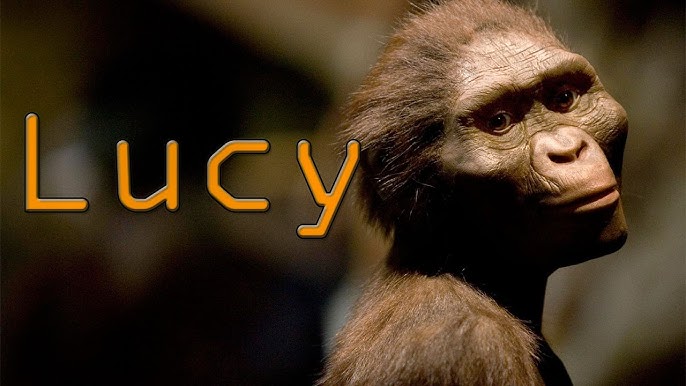Claimed to be the oldest ancestor of man: Who is Lucy? (Lucy Australopithecus)
Lucy is a 105 cm tall fossil, approximately 3.2 million years old, found in 1974 by the team of Frenchman Maurice Taieb and American paleontologist Donald Johanson in the Hadar region of Ethiopia in East Africa.

The name of the fossil was inspired by the girl mentioned in the song "Lucy in the Sky with Diamonds" by the Beatles. Because researchers agree that the find has similar characteristics to the fossil of the almost complete skeletal bones of a female who died at an adult age. While fossils this old are often found incomplete and heavily damaged, a surprising 40% of Lucy's skeleton was found.
Lucy's 'walking style' is shown as the most important evidence for the claim of human ancestors. Researchers who studied Lucy's skeleton say that she spent most of her time walking on two legs, especially based on the structure of her knee and the curvature of her spine. Since there is little evidence about the cause of Lucy's death, scientists speculate about how she did not die. However, they do not think that she was killed to be eaten by other animals, as there is not much evidence of tooth marks on the skeleton.
AL 288-1, commonly known as Lucy or Dinkinesh (which means "you are marvellous" in Amharic), is a collection of several hundred pieces of fossilized bone representing 40 percent of a female of the hominin species Australopithecus afarensis. It was discovered in 1974 in Ethiopia, at Hadar, a site in the Awash Valley of the Afar Triangle, by paleoanthropologist Donald Johanson of the Cleveland Museum of Natural History.
In fact, there is a single tooth mark from a predator on her left pelvis, but it is not known whether this mark was formed before or after Lucy died. According to the first data obtained in research on Lucy 45 years ago, Lucy belonged to the Australopithecus afarensis species, walked upright, and looked like a human, but was much shorter than a human's height. Although Lucy was an adult when she died, she was 1.1 m tall and weighed only 29 kg.
Lucy's skeleton is kept in a specially-made safe for her in the National Museum of Ethiopia in Addis Ababa. So where it is today is very close to where it was discovered. The skeleton exhibited to visitors in the museum is an exact copy of the real skeleton. However, the actual skeleton was exhibited in different places in the USA between 2007 and 2013. Plaster copies of Lucy's skeleton are found in different parts of the world.
The Hadar team collected hundreds more specimens of the same species, called Australopithecus afarensis. The missing parts of Lucy, including her skull, hands, and feet, were filled in with these parts. 20 years after Lucy was found, a team of more than 40 scientists, including Ethiopian researcher Berhane Asfaw, found a skeleton 1.2 million years older than Lucy, which they named Ardi. In 2000, another humanoid skeleton fossil, named Selam, was found by Ethiopian scientist Zeresenay Alemseged, known to be 120 thousand years older than Lucy.
In this list, we have compiled five important facts to know about Lucy.
1- Lucy's name comes from The Beatles' song Lucy in the Sky with Diamonds
After making the discovery, paleontologist Donald Johnson returned to the campsites with his team. Johnson put one of the Beatles' tapes into his cassette player and started playing Lucy in the Sky with Diamonds. Thereupon, one of the members of the excavation team suggested that the skeleton be named Lucy. "The skeleton suddenly turned into a human being," Johnson said in an interview with the BBC.
2- Lucy was walking upright
One of the most important things about Lucy was the way she walked. Scientists studying Lucy's skeleton discovered that she spent most of her time walking on two legs, based specifically on the structure of her knee and the curvature of her spine.
3- No one knows how she died
The little evidence about the cause of Lucy's death only shows us how she did not die, rather than providing definitive answers. There's little evidence of teeth marks on her skeleton, so it's unlikely she was killed to be eaten by other animals. In fact, there is a single tooth mark from a predator on her left pelvis, but it is not known whether this mark was formed before or after Lucy died.
4- Lucy is still in Ethiopia
Lucy's skeleton is kept in a specially-made safe for her in the National Museum of Ethiopia in Addis Ababa. So where it is today is very close to where it was discovered. The skeleton exhibited to visitors in the museum is an exact copy of the real skeleton. However, the actual skeleton was exhibited in different places in the USA between 2007 and 2013. Plaster copies of Lucy's skeleton are found in different parts of the world.
5- Lucy was quite short
Australopithecus afarensis walked upright and looked human-like, but was much shorter than us. Although Lucy was an adult when she died, she was 1.1 m tall and weighed only 29 kg.
